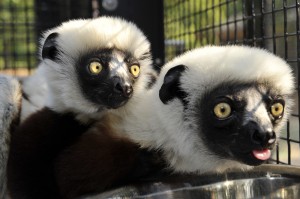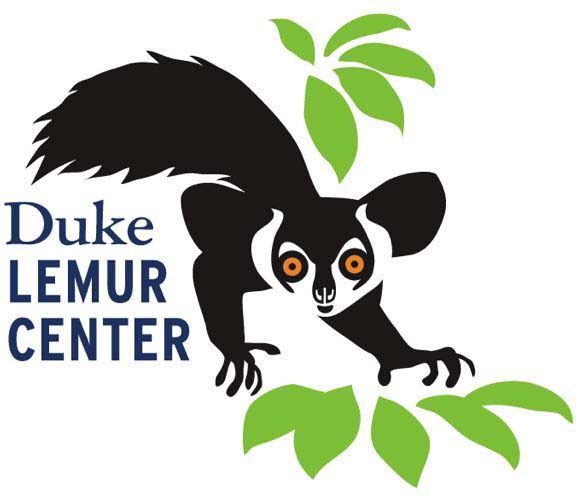May 30, 2014 — In 1999 at the Duke Lemur Center, a young lemur named Eugenius started to get sick. Very sick. He was lethargic, losing weight and suffering from diarrhea. Veterinarians soon pinpointed the cause of his illness: Eugenius tested positive for Cryptosporidium, a microscopic intestinal parasite known to affect people, pets, livestock and wildlife worldwide.

Coquerel’s sifakas, like this mother-baby pair, are the only lemur species out of 17 at the Duke Lemur Center to fall prey to Cryptosporidium, a waterborne illness that causes weakness and diarrhea. Young sifakas are more likely to get sick, but if researchers can figure out how older animals manage to fight the infection, they might be able to develop vaccines that provide infants the same protection. Photo by David Haring.
In humans, thousands of cases of Cryptosporidium are reported in the United States alone each year, spread primarily through contaminated water.
Since Eugenius was the first animal diagnosed in 1999, the parasite has caused periodic diarrhea outbreaks at the Duke Lemur Center. All of the infected animals are sifakas — the only lemur species out of 17 at the center known to fall prey to the parasite — and most of them were under age five when they got sick.
Despite various efforts to stop the infection, such as quarantining infected individuals and decontaminating their enclosures, more than half of the sifakas living at the center have tested positive for crypto at some point. While most animals recover, the pattern has veterinarians puzzled over why the outbreaks persist.
Now, thanks to advances in next-generation sequencing technology, researchers may be one step closer to understanding how these endangered animals fight the infection, and detecting the illness early enough to minimize its spread.
In a study published in the May 29, 2014, edition of Molecular Ecology Resources, Duke researchers Peter Larsen, Ryan Campbell and Anne Yoder used high-throughput sequencing on sifaka blood samples to generate sequence data for more than 150,000 different sifaka antibodies — protective molecules that latch on to bacteria, viruses and other foreign invaders in the body and fight them off before they cause infection.
Traditional sequencing methods can capture only a fraction of the millions of antibodies circulating in the bloodstream at a given time. But faster next-generation sequencing technology is enabling researchers to sequence a much larger portion of the antibody arsenal. The end result is a high-resolution ‘snapshot’ of antibody diversity that enables researchers to better understand how the immune system responds to stress and infection.
The research is part of a growing field called ecoimmunology, which aims to push the study of immunology beyond lab animals like fruit flies and mice and understand how immune systems function in real-world settings outside the lab.
The next step of the project will be to compare blood samples from healthy and sick lemurs, to see if researchers can identify the specific antibodies that play a role in binding to Cryptosporidium and neutralizing the infection — information that could be key to developing vaccines.
This research will likely lead to new methods of disease detection and treatment for lemurs in captivity, especially infected animals that show no outward signs of being sick. But it will also help researchers monitor the health status of lemurs and other primates living in the wild — simply by screening blood samples for antibody patterns indicating exposure to specific parasites.
That’s good news for lemurs in their native home of Madagascar, where lemurs live on the brink of extinction, and where human population growth makes contact with people and inter-species exchange of infectious disease increasingly likely.
CITATION: “Next-generation approaches to advancing eco-immunogenomic research in critically endangered primates,” Larsen, P., et al. Molecular Ecology Resources, 2014. http://onlinelibrary.wiley.com/doi/10.1111/1755-0998.12274/abstract

